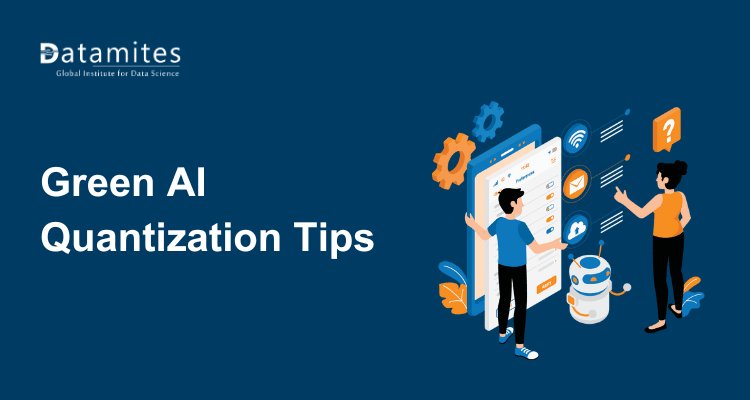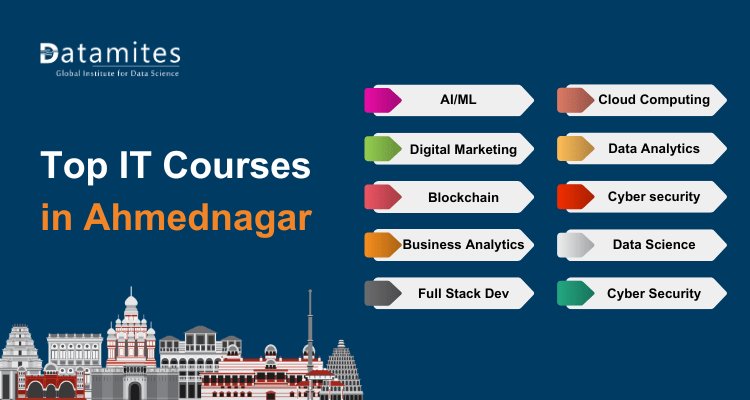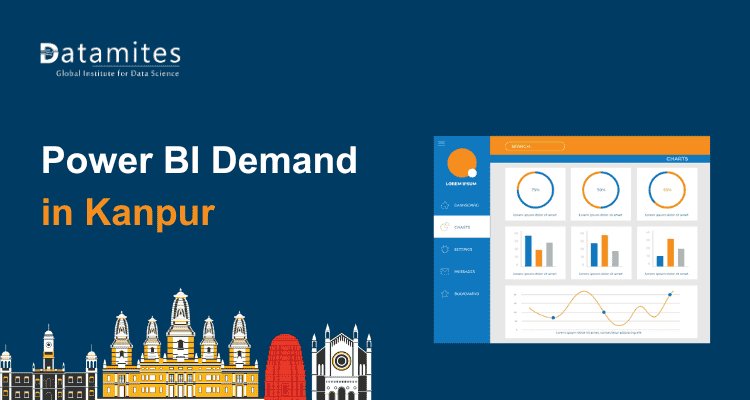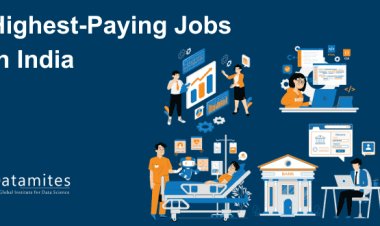Bias-Variance Tradeoff in Machine Learning
Discover the concept of the Bias-Variance Tradeoff in Machine Learning understand how bias and variance impact model performance, learn techniques to balance them, and explore real-world examples to build accurate, generalizable AI models.
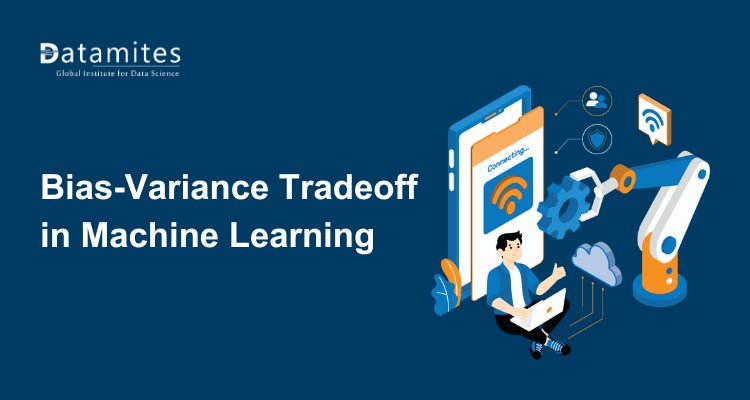
Machine learning models are designed to learn from data and make accurate predictions. However, creating a model that performs well on both training and unseen data is not as simple as it seems. Many models either underfit (failing to capture the data’s complexity) or overfit (performing well on training data but poorly on new data).
At the heart of this balance lies one of the most fundamental concepts in machine learning, the Bias-Variance Tradeoff. Understanding this tradeoff is crucial for building models that generalize well and deliver reliable results in real-world applications. Whether you’re a beginner in data science or an experienced practitioner, understanding how bias and variance impact your model can help you make better decisions during model selection, training, and evaluation.
What is Bias in Machine Learning?
Bias in machine learning refers to the error introduced by simplifying the real-world problem into a model that can be easily learned. A high-bias model makes strong assumptions about the data, often leading to underfitting when the model is too simple to capture the underlying patterns.
For example, using a linear regression model for highly non-linear data will result in high bias. The model may miss important trends, producing inaccurate predictions.
Key characteristics of high bias:
- Model is too simplistic
- Low flexibility
- High training and test error
- Poor performance on both seen and unseen data
What is Variance in Machine Learning?
Variance measures how much a model’s predictions change when trained on different subsets of the data. High variance indicates that the model is too sensitive to small fluctuations in the training data leading to overfitting.
A high-variance model fits the training data too closely, capturing noise rather than the actual pattern. As a result, while it performs well on the training data, it fails to generalize to new, unseen data.
Key characteristics of high variance:
- Model is overly complex
- Excellent training performance but poor test performance
- Sensitive to noise in data
- High generalization error
The generative AI market is experiencing a seismic growth trajectory, projected to surge from USD 71.36 billion in 2025 to USD 890.59 billion by 2032, at a CAGR of 43.4 % during the forecast period according to Markets and Markets.
Refer these below articles:
- What is Epoch in Machine Learning?
- What is Information Retrieval (IR) in Machine Learning?
- Data Preprocessing in Machine Learning
Understanding the Bias-Variance Tradeoff
The Bias-Variance Tradeoff represents the balance between two sources of error that affect a model’s performance:
- Bias error: From overly simplistic assumptions in the model.
- Variance error: From excessive sensitivity to training data.
When bias is high, the model underfits; when variance is high, it overfits. The challenge in machine learning is to find the optimal balance, a sweet spot where both bias and variance are minimized enough to achieve the lowest possible total error.
Mathematical Representation
The total expected error can be expressed as:
Total Error = Bias² + Variance + Irreducible Error
- Bias²: Error due to wrong assumptions or underfitting.
- Variance: Error due to excessive sensitivity to training data.
- Irreducible Error: Noise inherent in the data that cannot be reduced.
Visualizing the Tradeoff
If you plot model complexity against error:
- At low complexity → High bias, low variance.
- At high complexity → Low bias, high variance.
- The optimal model lies in between — where total error is minimized.
Bias-Variance Tradeoff in Different Algorithms
Different machine learning algorithms inherently exhibit varying levels of bias and variance. Understanding their tendencies helps in model selection and tuning.
1. Linear Regression
- High Bias, Low Variance: Assumes a linear relationship, leading to underfitting if the data is complex.
- Solution: Use Polynomial Regression or Regularization to adjust the balance.
2. Decision Trees
- Low Bias, High Variance: Very flexible and prone to overfitting small datasets.
- Solution: Apply Pruning or use Random Forests to reduce variance.
3. k-Nearest Neighbors (KNN)
Bias and Variance depend on k:
- Small k → Low bias, high variance
- Large k → High bias, low variance
Solution: Use cross-validation to find the optimal k.
4. Neural Networks
- High Variance Potential: Deep networks can overfit easily.
- Solution: Apply Dropout, Early Stopping, and Regularization to control variance.
The global wearable AI market size was estimated at USD 26,879.9 million in 2023 and is projected to reach USD 166,468.3 million by 2030, growing at a CAGR of 29.8% from 2024 to 2030. (Grand View Research)
Read these below articles:
Real-World Applications and Implications of Bias-Variance Tradeoff
The bias-variance tradeoff isn’t just a theoretical concept it plays a vital role in real-world AI and machine learning applications:
- Healthcare: In disease prediction models, high variance can lead to inconsistent diagnoses, while high bias might miss subtle symptoms. Balancing the tradeoff ensures accurate and reliable medical predictions.
- Finance: Risk prediction models must generalize well. Overfitted models might perform well on historical data but fail under new market conditions.
- Autonomous Vehicles: Machine learning models in self-driving cars need to handle diverse real-world scenarios. Too much bias could cause failure in complex environments, while high variance could lead to unpredictable behavior.
- E-commerce Recommendations: A balanced tradeoff ensures recommendations are neither too generic (high bias) nor too tailored (high variance).
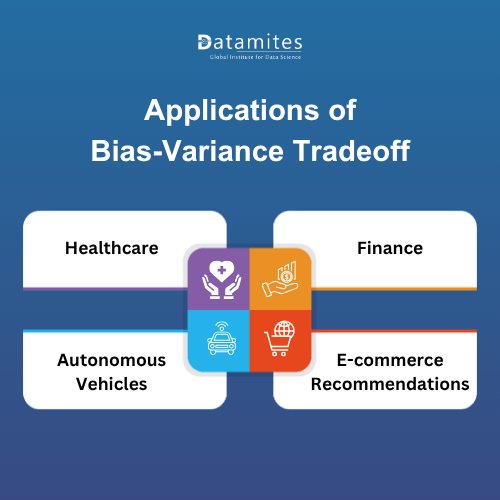
The Bias-Variance Tradeoff lies at the core of building effective machine learning models. High bias leads to underfitting, while high variance results in overfitting both harmful to performance. Striking the right balance ensures that models capture essential patterns without being misled by noise.
India is one of the fastest-growing markets for AI, with major industries adopting automation, data analytics, and machine learning at scale. From multinational companies to government-backed initiatives like Digital India and AI for All, there’s a high demand for skilled AI professionals who can build intelligent systems and drive innovation. Enrolling in an artificial intelligence course in india has become one of the smartest career decisions for students, professionals, and tech enthusiasts who want to stay ahead in the data-driven era.
The DataMites Machine Learning Course in India is designed to meet the needs of both newcomers and seasoned professionals. The program emphasizes hands-on, project-based learning, enabling participants to apply theoretical concepts to real-world data challenges effectively. With comprehensive placement assistance, the course equips learners to excel in India’s rapidly growing tech and data-driven industries. Upon successful completion, graduates receive globally recognized certifications from IABAC and NASSCOM FutureSkills, enhancing their professional credibility and opening doors to rewarding career opportunities in Machine Learning and related fields.


